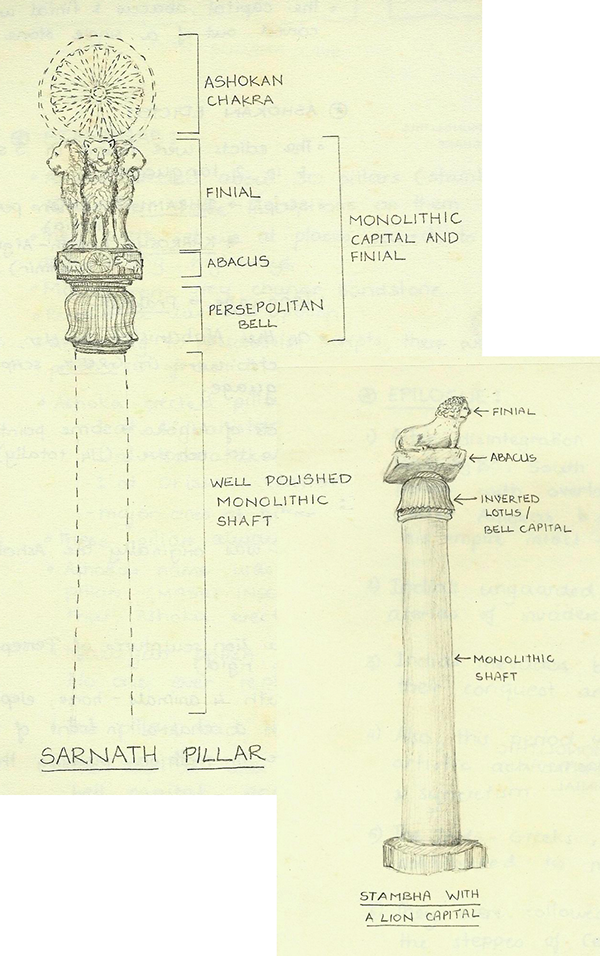-
Chapter 2: MAURYAN AND POST MAURYAN ART
Introduction
Mauryan art was influenced by Persian and
Greek culture.
Pillars:
1. Great buddhist Emperor Ashok first to “Think in Stone”. His pillars were lofty, heighted, monolithic, crowned on top with Animals and inscribed with Buddhist concept of morality, humanity and piety.
The purpose was to declare victory, Symbolize
the state and preach moral values.

Fig 1: Mauryan Pillar
3. Influence of Greek seen in the bell shaped capital and Persian seen in highly polished pillars. However Mauryan pillars were monolithic and Greek were made of multiple stones.
Emperor Ashok started using stones in sculptures and monuments whereas the preceding dynasties used wood or clay.Rock cut architecture to began with the
Mauryans.
The Mauryan era caves were viharas and Post Mauryan caves were Chaityas. These caves had artistic gateways and polished interiors. Caves were used as resting places for monks or Ajivikas sect used them.
Post Mauryan period: This saw the climax of sculptures. Cave architecture also developed and caves became viharas and chaityas [place of worship].
Three schools of sculptures and their features:
1. Gandhar school
2. Mathura school
3. Amaravati school
Gandhar School of Art:
1.
Outside influence of Greek and Roman.
2. Grey sandstone
3. Completely Buddhist
4. Patronized by Kushana. Located in North West Frontier Province.
5. Spiritual Buddha – bearded, eyes closed, yogic posture, wavy hair, large ears.
6.
Most important contribution is beautiful
sculptures of Buddha and Boddisattvas.
Mathura School of Art:
1. Indigenous influence
2. Red sandstone
3. All three religions. Patronized by Kushana. Located in UP.
4.
Delighted Buddha – Padmasana, masculine,
grace on the face, energetic body.
Amaravati School of Art:
1. indigenous influence
2. white marble.
3. Buddhist dominated
4. Satvahana dynasty patronised. Located in Krishna Godavari valley
5. narrative art. Depicting life of Buddha and themes from Jataka tales.

Note: Buddha has attained enlightenment and
Boddisatavas are still candidates for it. Chaitya is a
church and Vihara is a monastery. Sangharams are monastary
as well as schools for monks.
Solved Question Paper
Q. Who among the following was/were associated with the introduction of Ryotwari Settlement in India during the British rule?
1. Lord Cornwallis
2. Alexander Reed
3. Thomas Munro
Select the correct answer using the code given below: (UPSC CSAT 2017)
1 only
1 and 3 only
2 and 3 only
1, 2 and 3
Ans . C
Cornwallis not involved in ryotwari but only permanent settlement.
Q. Consider the following pairs:
1. Radhakanta Deb: First President of the British Indian Association
2. Gazulu Lakshminarasu Chetty: Founder of the Madras Mahajana Sabha
3. Surendranath Banerjee: Founder of the Indian Association
Which of the above pairs is/are correctly matched?
1 only
1 and 3 only
2 and 3 only
1, 2 and 3
Ans . B
The earliest political organisation, the Madras Native Association was started in July 1852.
Lakshminarasu Chetty and Srinivasa Pillai were the founders of this organization.
The Madras Native Association was sharply critical of the policies of the East India Company’s rule.
Subsequently in 1884, the Madras Mahajana Sabha was established by P. Anandacharlu and P. Rangaiya Naidu. The Madras Native Association was ultimately merged with this organization.
Q. Which of the following kingdoms were associated with the life of Buddha?
1. Avanti
2. Gandhara
3. Kosala
4. Magadha
Select the correct answer using the code given below (UPSC CSAT 2015)
1,2 and 3
2 and 3 only
1,3 and 4
3 and 4 only
Ans . D
Magadha, Kosala, Vaishali, Vajji etc were the kingdoms and regions that the wandering Buddha covered relentlessly.
Jetavana (Jeta garden) was perhaps the best known amongst the beautiful gardens provided to Buddha’s entourage and it was close to Sravasthi, capital of the Kosala kingdom.
Perhaps the second-most important monastic resort of Buddha was the “bamboo grove” in Rajgriha, capital of Magadha, provided by king Bimbisara.
Quiz
Score more than 80% marks and move ahead else stay back and read again!